Huawei BAH-L09, BAH-W09 User Manual




 MediaPad M3 Lite 10
MediaPad M3 Lite 10
User Guide
Contents
Foreword
Getting Started
Initial setup |
2 |
Connecting to the Internet |
2 |
Transferring data from another device |
3 |
Charging your device |
4 |
Screen and Display
Home screen |
6 |
Locking and unlocking the screen |
10 |
Notification panel and status bar |
12 |
Global search |
14 |
Screenshot |
15 |
Screen recording |
17 |
Split-screen mode |
19 |
Eye comfort mode |
21 |
Display settings |
22 |
Network and Sharing
Mobile Internet |
24 |
|
Wi-Fi |
26 |
|
Bluetooth |
27 |
|
Using Huawei Share to transfer files between two Huawei |
29 |
|
devices |
||
|
Security and Backup
Fingerprint recognition |
30 |
Backing up and restoring data |
31 |
File management |
33 |
Camera and Gallery
Photos and video recordings |
36 |
Time-lapse mode |
37 |
Audio notes |
37 |
Viewing photos and videos |
37 |
Sharing photos and videos |
38 |
Editing a photo |
39 |
Editing a video |
40 |
Contacts and Email
Creating a contact card |
42 |
Creating a new contact |
42 |
i
|
Contents |
Importing and exporting contacts |
43 |
Managing contacts |
44 |
Sharing contacts |
45 |
Contact groups |
45 |
Adding an email account |
46 |
Sending emails |
47 |
Replying to emails |
47 |
Searching emails |
47 |
Managing email accounts |
48 |
Calls and Messaging(Applicable to selected models)
Making calls |
49 |
Answering calls |
50 |
Managing call logs |
52 |
Sending a message |
52 |
Replying to a message |
53 |
Calendar and Notepad
Viewing global holidays |
54 |
Birthday reminders |
54 |
Creating an event |
54 |
Sharing events |
55 |
Searching for events |
55 |
Creating a note |
55 |
Managing notes |
55 |
Music and Video
Listening to music |
57 |
Searching for music |
57 |
Deleting songs |
57 |
Playing a video |
58 |
Tablet Manager
Optimizing performance |
59 |
Harassment filter |
59 |
Battery management |
59 |
Virus scanner |
60 |
Tools
Clock |
61 |
Sound recorder |
63 |
System Features and Settings
Power on and off timer |
64 |
Restarting your device |
64 |
ii
|
Contents |
Changing the system language |
64 |
Changing the input method |
64 |
Input method settings |
65 |
Editing text |
65 |
Airplane mode |
66 |
Configuring the sound settings |
66 |
Do not disturb mode |
68 |
Setting up an account |
68 |
Viewing memory and storage information |
69 |
Setting the date and time |
69 |
Enabling location access |
70 |
Restoring factory settings |
70 |
OTA updates |
71 |
Viewing product information |
71 |
Accessibility features |
72 |
Obtaining help
Personal Information and Data Security
Legal Notice
iii

Foreword
Read this guide carefully before using your device.
All pictures and illustrations in this document are for your reference only and may differ from the final product.
Some features in this guide may not be supported by certain devices or carriers.
Symbols and definitions
Description
Highlights important information and tips, and provides additional information.
Reminder
Indicates potential problems that may arise if proper care or attention is not given, such as device damage or data loss.
Warning
Warns you about potential hazards that could cause serious injury.
1

Getting Started
Initial setup
 • Ensure that the SIM card is inserted correctly before using your tablet for the first time. Read the Quick Start Guide for more information on how to set up your tablet. SIM cards are not supported on Wi-Fi only tablets.
• Ensure that the SIM card is inserted correctly before using your tablet for the first time. Read the Quick Start Guide for more information on how to set up your tablet. SIM cards are not supported on Wi-Fi only tablets.
•Press and hold the power button to turn on your device. Follow the onscreen instructions to complete the initial setup.
1 Select your language and region and touch NEXT.
2Read the content carefully, accept the user terms and conditions, and then touch AGREE >
AGREE.
3 Read the service policy. Select AGREE and touch NEXT.
4Your device will automatically search for available Wi-Fi networks. Follow the onscreen instructions to connect to a network.
5 Read the Google terms and conditions and touch NEXT.
6You can configure your device in two ways:
• Follow the onscreen instructions to restore a backup.
• Follow the onscreen instructions to copy data from another device, or touch SET AS NEW PHONE > OK to skip this step.
 If you choose to skip this step, you can still import data from another device later by touching Settings > Advanced settings > Data transmission.
If you choose to skip this step, you can still import data from another device later by touching Settings > Advanced settings > Data transmission.
7 Touch GET STARTED to complete the settings. Your device is now ready to use.
Connecting to the Internet
Connect to Wi-Fi networks effortlessly with your device.
Connecting to a Wi-Fi network
1 |
Swipe down from the status bar to open the notification panel. |
|
2 |
Touch and hold |
to open the Wi-Fi settings screen. |
3 |
Switch on Wi-Fi. Your device will list all available Wi-Fi networks at your location. |
|
4Select the Wi-Fi network you want to connect to. If you select an encrypted network, you will also need to enter the Wi-Fi password.
2
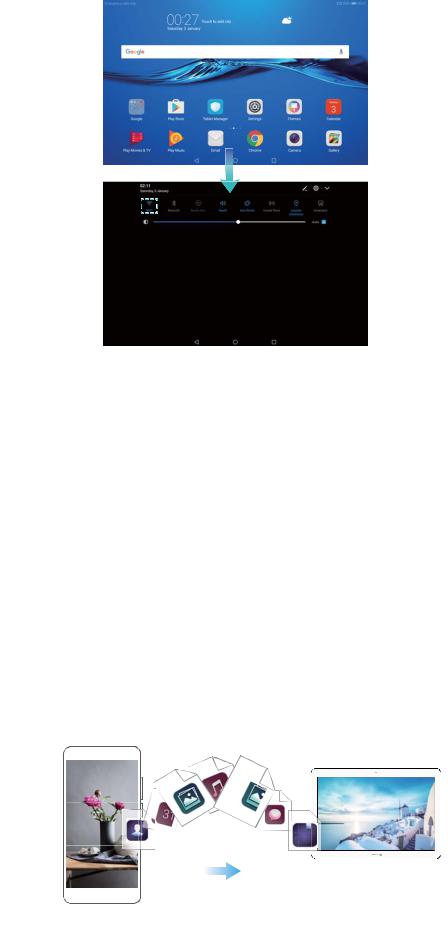
Getting Started
Connecting using mobile data
 Before using mobile data, ensure that you have a data plan with your carrier to avoid incurring excessive data charges. Mobile data is not supported on Wi-Fi only tablets.
Before using mobile data, ensure that you have a data plan with your carrier to avoid incurring excessive data charges. Mobile data is not supported on Wi-Fi only tablets.
1 Swipe down from the status bar to open the notification panel.
2 Touch  to enable mobile data.
to enable mobile data.
 Disable mobile data when not required so as to save battery power and reduce data usage.
Disable mobile data when not required so as to save battery power and reduce data usage.
Transferring data from another device
Import data from another tablet in a few simple steps.
Copying data to your new device
1
2
Open Settings.
Settings.
Touch Advanced settings > Data transmission.
3
Getting Started
Using Phone Clone to import data
Phone Clone is an app developed by Huawei that allows you to transfer data between devices without a computer or Internet connection.
1
2
3
4
On your old device, install Phone Clone.
On your new device, open Settings.
Settings.
Touch Advanced settings > Data transmission > Phone Clone.
Select the device from which you want to import data and touch Continue.
5On your old device, open Phone Clone and touch send. Scan the QR code on the new device or manually connect to the new device's Wi-Fi hotspot.
 To install Phone Clone on your old device, touch Touch here to generate a QR code on your new device and scan the QR code.
To install Phone Clone on your old device, touch Touch here to generate a QR code on your new device and scan the QR code.
6 Once connected, select the data you want to send on your old device and touch send.
Using HiSuite to import data
Use HiSuite to back up data on your old device to a computer and import it to your new device.
1 Install HiSuite on your computer.
2 Use a USB cable to connect your device to your computer. HiSuite will launch automatically.
3Go to the backup screen in HiSuite. Select the data that you want to back up and follow the onscreen instructions to back up the data.
4Connect your new device to your computer with a USB cable. Go to the data restore screen in HiSuite.
5Choose which backup you want to restore and follow the onscreen instructions to restore the data.
Charging your device
Your device displays a low battery warning when the battery is nearly empty. Charge your device immediately to prevent it from switching off automatically.
Using a charger to charge your device
Connect your device to a socket using the factory-provided charger and USB cable.
 • If your device does not respond when you press the power button, the battery is probably empty. Charge your battery for at least 10 minutes (use the charger that came with your device), and then restart your device.
• If your device does not respond when you press the power button, the battery is probably empty. Charge your battery for at least 10 minutes (use the charger that came with your device), and then restart your device.
•Your device automatically conducts a safety check when you connect it to a charger or other devices. If your device detects that the USB port is wet, it will automatically stop charging and display a safety message. If this message is displayed, unplug the USB cable from your device and allow the USB port to dry out completely to avoid damaging your device or battery.
4

Getting Started
Using a USB port to charge your device
If you do not have access to a charger, you can charge your device by connecting it to a computer with a USB cable.
1When you use a USB cable to connect your device to a computer or another device, Allow access to device data? will be displayed in a popup dialog.
2 Touch No, charge only.
If another USB connection mode has been selected, swipe down from the status bar to open the notification panel. Touch File transfer via USB, and then select Charge only.
Safety information
• Only use genuine Huawei batteries, chargers, and USB cables to charge your device. Thirdparty accessories are a potential safety hazard and may impair your device's performance.
• You can recharge your battery many times, but all batteries have a limited lifespan. If you notice a significant deterioration in your device's battery life, purchase a genuine Huawei replacement battery. Do not attempt to remove built-in batteries. If your device has a built-in battery, contact an authorized Huawei service center for a replacement. If the battery is removable, replace it with a genuine Huawei battery.
• Your device may become warm after prolonged use or when exposed to high ambient temperatures. If your device becomes hot to the touch, stop charging it and disable unnecessary features. Place your device in a cool location and allow it to cool down to room temperature. Avoid touching the surface of your device for prolonged periods when it becomes hot.
• Charging times may vary depending on the ambient temperature and the remaining battery level.
• Avoid using your device when it is charging. Do not cover your device or the charger.
 For more information on charging and battery care, visit http://consumer.huawei.com/ and search for your device's user guide.
For more information on charging and battery care, visit http://consumer.huawei.com/ and search for your device's user guide.
Battery status information
The battery status is indicated by your device's indicator light and the battery icon in the status bar.
Status indicator |
Battery icon |
Battery status |
Blinking or steady red |
|
Less than 4% remaining |
|
|
|
Red |
|
Charging, less than 10% remaining |
|
|
|
Orange |
|
Charging, 10–90% remaining |
|
|
|
Green |
|
Charging, at least 90% remaining. If 100% is displayed |
|
|
next to the battery icon in the status bar, or a charging |
|
|
complete message is displayed on the lock screen, this |
|
|
indicates that charging is complete. |
|
|
|
5
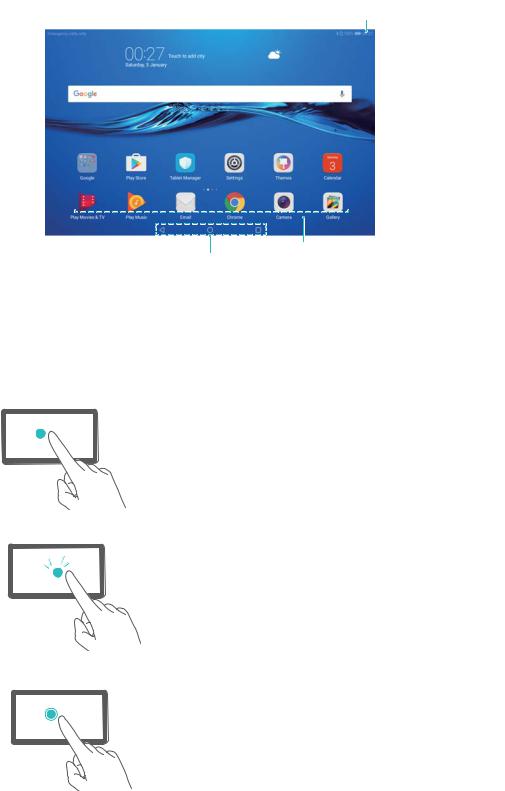
Screen and Display
Home screen
About the home screen
Use the home screen to access your apps and widgets.
Status bar: Displays notifications and status icons
Display area:  Displays app icons, folders, and widgets
Displays app icons, folders, and widgets
Screen position indicator:


 Indicates which home
Indicates which home 
 screen is displayed
screen is displayed
Dock bar: Displays frequently used apps
Navigation bar: Displays virtual navigation keys
Basic screen gestures
Use simple touchscreen gestures to perform a variety of tasks, such as launch apps, scroll through lists, and enlarge images.
Touch: Touch an item once. For example, touch to select an option or open an app.
Double touch: Touch the target area of the screen twice in quick succession. For example, double touch an image in full screen mode to zoom in or out.
Touch and hold: Touch and hold the target area of the screen for at least 2 seconds. For example, touch and hold a blank area on the home screen to access the home screen editor.
6
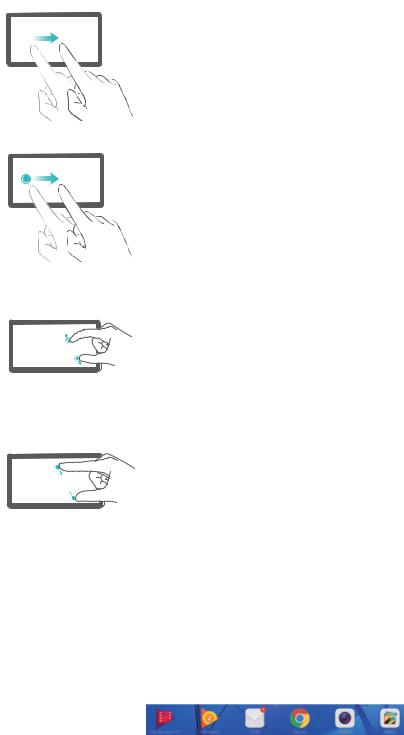
Screen and Display
Swipe: Swipe your fingers on the screen. Swipe vertically or horizontally to browse other home screens, scroll through a document, and more.
Drag: Touch and hold an item, and then move it to another position. For example, use this gesture to rearrange apps and widgets on the home screen.
Spread fingers apart: Spread two fingers apart on the screen. For example, spread two fingers apart to zoom in on a picture or web page.
Pinch fingers together: Pinch two fingers together on the screen. For example, pinch two fingers together to zoom out on an image.
Displaying or hiding notification badges
Notification badges appear in the top-right corner of app icons. The badge number indicates the number of new notifications. Open the corresponding app to view notification details.
1
2
3
On the home screen, pinch two fingers together to open the home screen editor.
Touch Settings > Badge app icons.
Toggle the corresponding switch to enable or disable notification badges.
Setting the home screen wallpaper
Choose from a wide range of themes and wallpapers to personalize your device.
Changing the wallpaper
1
2
Open  Settings.
Settings.
Touch Display > Wallpaper > Set wallpaper.
7

Screen and Display
3Select the desired wallpaper and follow the onscreen instructions to set it as the home screen or lock screen wallpaper (or both).
Changing the wallpaper automatically
1
2
3
Open  Settings.
Settings.
Touch Display > Wallpaper.
Switch Randomly change home screen wallpaper on or off.
 When Randomly change of home screen wallpaper is enabled, you can configure the Interval and Album to display so that your wallpaper can change automatically at the specified interval.
When Randomly change of home screen wallpaper is enabled, you can configure the Interval and Album to display so that your wallpaper can change automatically at the specified interval.
Managing home screens
You can customize home screens to your liking.
Adding home screens
1
2
On the home screen, pinch two fingers together to open the home screen editor.
Touch  on the home screen furthest to the left or right to add a new screen.
on the home screen furthest to the left or right to add a new screen.
Deleting home screens
1 On the home screen, pinch two fingers together to open the home screen editor.
2 Touch  on a blank screen to delete it.
on a blank screen to delete it.
8

Screen and Display
 You cannot delete a home screen if it contains apps or widgets.
You cannot delete a home screen if it contains apps or widgets.
Moving home screens
1 On the home screen, pinch two fingers together to open the home screen editor.
2 Touch and hold the home screen you want to move and drag it to the desired location.
Setting the default home screen
1 On the home screen, pinch two fingers together to open the home screen editor.
2 Touch at the top of a home screen to set the chosen home screen as default.
Managing home screen widgets
Add, move, or delete widgets from the home screen.
Adding widgets
1 On the home screen, pinch two fingers together to open the home screen editor.
2 Touch Widgets. Select a widget and drag it to a blank area on the home screen.
 You must have enough space on the home screen. If there is not enough space, add another home screen or free up some space.
You must have enough space on the home screen. If there is not enough space, add another home screen or free up some space.
9
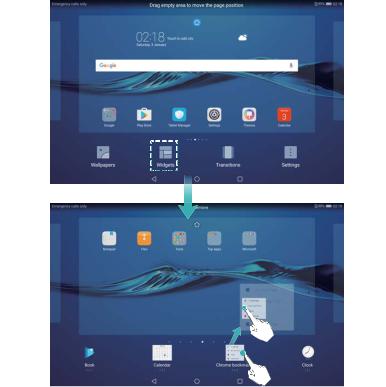
Screen and Display
Moving widgets
On the home screen, touch and hold a widget until your device vibrates, and then drag the widget to the desired location.
Deleting widgets
On the home screen, touch and hold a widget until your device vibrates, and then drag the widget to Remove at the top of the screen.
Locking and unlocking the screen
Changing the lock screen style
Set a screen lock password to prevent unauthorized access to your device.
Changing the screen lock method
Magazine Unlock is set as the default lock screen style. To change the lock screen style, touch
 Settings > Screen lock & passwords > Screen lock style and select a style.
Settings > Screen lock & passwords > Screen lock style and select a style.
Setting the screen lock password
1
2
Open  Settings.
Settings.
Touch Screen lock & passwords > Password
3You can choose to unlock the screen with an unlock pattern, PIN, or password:
• Touch Pattern and connect at least four dots twice to create a screen unlock pattern.
• Touch PIN. Follow the onscreen instructions to create a PIN containing at least four digits, and then touch OK.
10
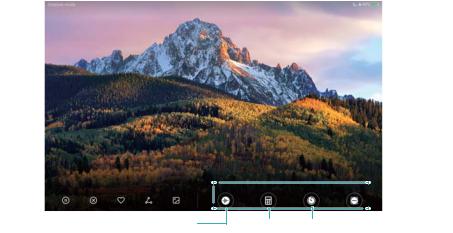
Screen and Display • Touch Password. Follow the onscreen instructions to create a password containing at least
four characters, and then touch OK.
 To remove the screen lock password, touch None and follow the onscreen instructions.
To remove the screen lock password, touch None and follow the onscreen instructions.
Locking the screen
Lock the screen to reduce power consumption and prevent unintended presses or unauthorized access to your data.
• Manual lock: Press the Power button to manually lock the screen.
• Automatic lock: The screen will lock automatically and enter sleep mode after the preset sleep time to reduce power consumption and prevent unintended operations.
 To change the screen sleep time, touch
To change the screen sleep time, touch  Settings > Display > Sleep and select a time.
Settings > Display > Sleep and select a time.
Unlocking the screen
1 Press the Power button to turn on the screen.
2 Swipe on the screen in any direction.
 If you have set a screen unlock pattern, PIN, or password, you will need to draw the unlock pattern or enter your PIN/password to unlock the screen.
If you have set a screen unlock pattern, PIN, or password, you will need to draw the unlock pattern or enter your PIN/password to unlock the screen.
Accessing tools from the lock screen
Launch apps directly from the lock screen.
1 Swipe up from the bottom of the lock screen to display lock screen features and tools.
2 Touch the shortcut icon on the bottom of the screen to launch the app you want to access.
 Scanner
Scanner
Recorder |
Calclator Clock |
|
 Swipe up on the camera icon on the lock screen to directly open the camera.
Swipe up on the camera icon on the lock screen to directly open the camera.
Configuring your lock screen signature
Configure a lock screen signature to personalize your lock screen.
1 Open  Settings.
Settings.
2 Touch Screen lock & passwords > Lock screen signature.
11

Screen and Display
3 Enter your lock screen signature and touch Save.
Your lock screen signature will be displayed on the lock screen.
Notification panel and status bar
About the status bar
Use the status bar to access the notification panel and check your device's status.
Opening the notification panel and status bar
Opening the notification panel and status bar from the lock screen
Turn on the screen and swipe down from the status bar to open the notification panel. Then you can switch on or off shortcut switches, or view notification messages.
Opening the notification panel and status par when the screen is unlocked
Swipe down from the status bar to open the notification panel. Then you can switch on or off shortcut switches, or view notification messages.
About notification and status icons
Status icons
Status icons are displayed on the right-hand side of the notification bar and tell you about your device's status, including network connections, signal strength, battery, and time.
 Status icons may vary according to your region or carrier.
Status icons may vary according to your region or carrier.
Roaming |
Airplane mode enabled |
|
|
Bluetooth enabled |
Connected over Wi-Fi |
|
|
Wi-Fi network available |
Receiving location data from GPS |
|
|
Vibration mode enabled |
Silent mode enabled |
|
|
Alarm enabled |
Charging |
|
|
Battery full |
Battery low |
|
|
Headset inserted |
No SIM card found |
|
|
Notification icons
Notification icons are displayed on the left-hand side of the status bar when you receive a new message, notification, or reminder.
Missed calls |
New emails |
12

|
|
|
|
|
|
|
Screen and Display |
|
|
|
|
Downloading data |
|
|
Uploading data |
|
|
|
|
|
|
|
||||
|
|
|
|
|||||
|
|
|
|
|
|
|
|
|
|
|
|
|
|
|
|
|
|
|
|
|
Upcoming events |
|
|
Device memory full |
||
|
|
|
|
|
|
|
|
|
|
|
|
Synchronizing data |
|
|
Synchronization failed |
||
|
|
|
|
|
|
|
|
|
Configuring notifications
You can configure the notification settings for each app.
1
2
3
Open  Settings.
Settings.
Touch Notification & status bar > Notifications management.
Select the app that you want to configure and enable or disable notifications as desired.
Configuring the screen to turn on when you receive a notification
Configure the screen to turn on when you receive a new notification to avoid missing important information.
1
2
3
Open  Settings.
Settings.
Touch Notification & status bar.
Toggle the Notifications turn on screen switch.
Configuring the status bar
Open  Settings, touch Notification & status bar. Toggle the Display carrier name, Display network speed, or Battery percentage switches to configure which information is displayed in the status bar.
Settings, touch Notification & status bar. Toggle the Display carrier name, Display network speed, or Battery percentage switches to configure which information is displayed in the status bar.
Using shortcut switches to access settings
Use shortcut switches to quickly enable or disable frequently-used features.
Accessing shortcut switches
Swipe down from the status bar to open the notification panel.
 Touch
Touch  to display all of the shortcut switches.
to display all of the shortcut switches.
Configuring shortcut switches
1 Swipe down from the status bar to open the notification panel.
2 Touch  . Touch and hold a switch and drag it to the desired position.
. Touch and hold a switch and drag it to the desired position.
13

Screen and Display
3Touch a switch to enable the corresponding feature. If the switch supports touch and hold gestures, touch and hold the switch to access the settings for the corresponding feature.
 Some switches do not support touch and hold gestures.
Some switches do not support touch and hold gestures.
Global search
About global search
Use global search to find apps, contacts and messages on your device.
Swipe down on the home screen to open the global search window, and then enter your search terms.
14

Screen and Display
Searching for content on your device
Searching for contacts
1 Swipe down on the home screen to display the search bar.
2Touch the search bar and enter the contact name, initials, phone number, email address, or other information. Matching results will be displayed underneath.
 To improve the accuracy of search results, enter more than one keyword. Each keyword should be separated by a space (for example "John Smith New York").
To improve the accuracy of search results, enter more than one keyword. Each keyword should be separated by a space (for example "John Smith New York").
Searching for SMS messages
1
2
Swipe down on the home screen to display the search bar.
Enter one or more keywords. The results will be displayed underneath the search bar.
 Alternatively, open
Alternatively, open  Messaging and enter one or more keywords in the search bar.
Messaging and enter one or more keywords in the search bar.
Searching for emails
1 Swipe down on the home screen to display the search bar.
2Enter one or more keywords (such as the email subject). The results will be displayed underneath the search bar.
Searching for apps
1 Swipe down on the home screen to display the search bar.
2 Enter one or more keywords. The results will be displayed underneath the search bar.
 When using the Drawer home screen layout, you can also search for apps by touching
When using the Drawer home screen layout, you can also search for apps by touching 
 and entering the app name in the search bar.
and entering the app name in the search bar.
Searching for settings
1 Swipe down on the home screen to display the search bar.
2Enter one or more keywords. Matching menu options from Settings will be displayed under the search bar.
Screenshot
Capturing the entire screen
Taking a screenshot with the power and volume down buttons
Press the Power button and Volume down button to take a full screenshot.
15

Screen and Display
Screenshot shortcut
Open the notification panel, and then touch  in the Shortcuts tab to take a full screenshot.
in the Shortcuts tab to take a full screenshot.
Taking scrolling screenshots
Using the shortcuts tab
1 |
Open the notification panel, and then touch |
to take a standard screenshot. |
|
2 |
After taking the screenshot, touch |
to take a scrolling screenshot. |
|
3 |
The screen will scroll down automatically as your device captures a screenshot. |
||
16

Screen and Display
Ensure that you touch |
within 3 seconds of taking the screenshot. |
Screen recording
About screen recordings
Use the screen recording feature to record footage and share it with friends.
Screen recorder
Using the screen recorder shortcut switch
To start a screen recording, open the notification panel and touch  .
.
Pressing buttons to record
Press the Volume up button and Power button simultaneously.
17

Screen and Display
 • Audio will also be recorded, so make sure that you are in a quiet environment.
• Audio will also be recorded, so make sure that you are in a quiet environment.
•Recording will stop automatically when you make or receive a call.
•When making a screen recording, you will not be able to use the recording feature in other applications.
•Longer recordings will take up more space on your device's internal storage, so ensure there is enough space before recording.
You can stop a screen recording in two ways:
• Press the volume up and power buttons simultaneously.
• Touch the screen recording icon in the upper left corner of the status bar.
Viewing, sharing, and deleting screen recordings
Viewing screen recordings
Open  Gallery and go to Screenshots or Screen recordings to view your screen recordings.
Gallery and go to Screenshots or Screen recordings to view your screen recordings.
Sharing screen recordings
1
2
3
4
Open  Gallery.
Gallery.
On the Albums tab, touch Screenshots or Screen recordings.
Select the screen recording you want to share and touch 
 .
.
Choose how you want to share the recording and follow the onscreen instructions.
Deleting screen recordings
1
2
3
4
Open  Gallery.
Gallery.
On the Albums tab, touch Screenshots or Screen recordings.
Touch and hold the screen recording that you want to delete and select  . Touch Delete.
. Touch Delete.
18

Screen and Display
Configuring the default storage location for screen recordings
 Not all devices support microSD cards.
Not all devices support microSD cards.
1
2
Insert a microSD card into your device.
Open  Settings.
Settings.
3Touch Memory & storage > Default location to set the default storage location to Internal storage or SD card.
Split-screen mode
About split-screen mode
Use split-screen mode to use two apps at once.
Enabling split screen mode
Split screen mode is not available for all apps. Some apps may not function properly in split screen mode.
Using the Recent key to enable split screen mode
Open an app that supports split-screen mode, and then touch and hold  .
.
Using swipe gestures to enable split screen mode
Open an app that supports split screen mode, and then swipe up from the bottom of the screen with two fingers.
Using split screen mode
Switching to full screen mode
In split screen mode, touch and hold  and swipe left or right to switch to full screen mode.
and swipe left or right to switch to full screen mode.
19
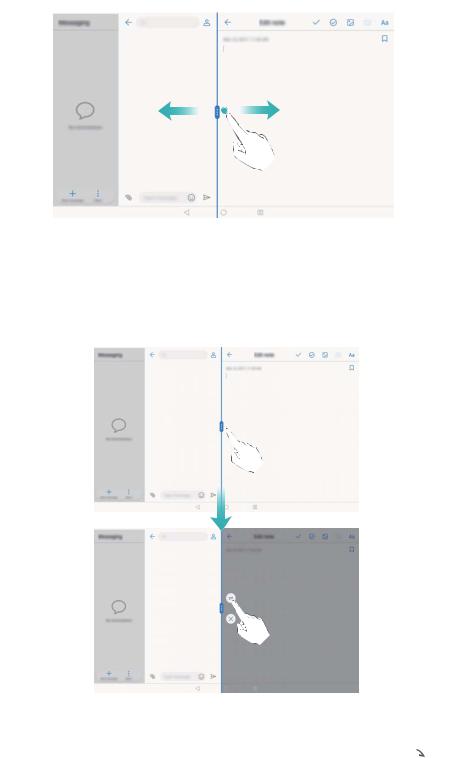
Screen and Display
Moving screens
In split screen mode, touch 

 , and then touch
, and then touch 
 to switch the position of the screens.
to switch the position of the screens.
Changing the screen orientation
Swipe down from the status bar to open the notification panel. Touch the  switch to enable automatic screen rotation.
switch to enable automatic screen rotation.
20
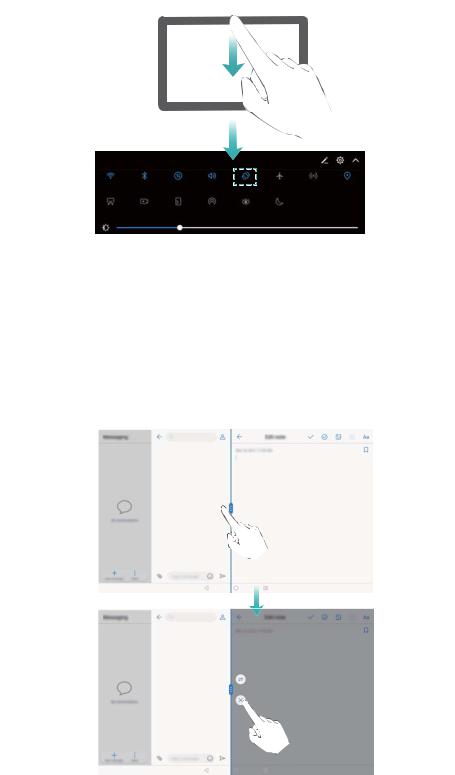
Screen and Display
Accessing the home screen
In split screen mode, touch  to access the home screen.
to access the home screen.
Exiting split-screen mode
To exit split-screen mode, touch  and select
and select  .
.
Eye comfort mode
Eye comfort mode decreases the amount of blue light emitted from the screen to reduce eye strain.
Eye comfort mode
1
2
Open  Settings.
Settings.
Touch Display > Eye comfort and switch on Eye comfort.
21

Screen and Display
 When eye comfort mode is enabled,
When eye comfort mode is enabled,  will be displayed in the status bar.
will be displayed in the status bar.
Adjusting the color temperature
Eye comfort mode reduces the amount of blue light emitted from the screen, which may give the screen a slightly yellow hue. You can adjust the color temperature to control the amount of blue light.
When Eye comfort is enabled, swipe left or right on the color temperature slider to make the screen hue cooler or warmer.
Enabling and disabling eye comfort mode
You can use the shortcut switch in the notification panel to enable to disable eye comfort mode.
Swipe down from the status bar. Touch  to display all shortcut switches, and then toggle the
to display all shortcut switches, and then toggle the
switch.
Configuring the timer
Configure the timer to enable eye comfort mode automatically at a preset time, such as when you finish work or before you go to bed.
1
2
3
Open  Settings.
Settings.
Touch Display > Eye comfort.
Switch on Schedule and configure the Start time and End time.
Display settings
Changing the font size
1
2
Open  Settings.
Settings.
Touch Display > Font size and choose a font size.
22
